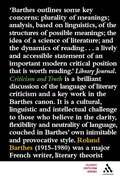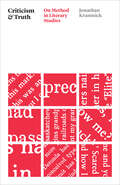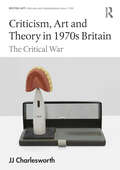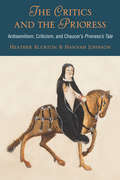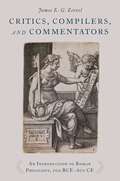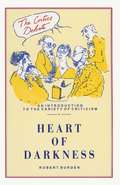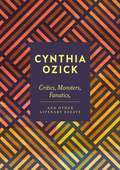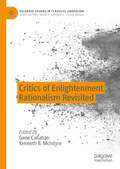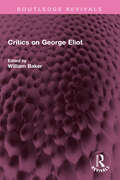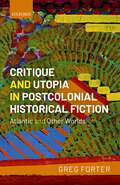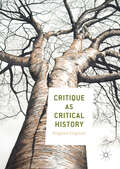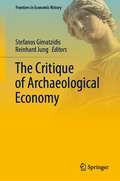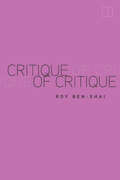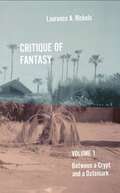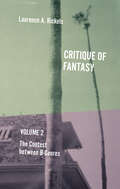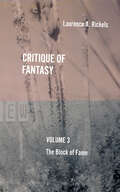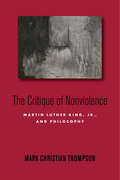- Table View
- List View
Criticism and Truth (Classic Criticism)
by Roland Barthes Katrine Pilcher KeunemanRoland Barthes (1915-1980) was a major French writer, literary theorist and critic of French culture and society. His classic works include Mythologies and Camera Lucida. Criticism and Truth is a brilliant discussion of the language of literary criticism and a key work in the Barthes canon. It is a cultural, linguistic and intellectual challenge to those who believe in the clarity, flexibility and neutrality of language, couched in Barthes' own inimitable and provocative style.
Criticism and Truth: On Method in Literary Studies (Thinking Literature)
by Jonathan KramnickA defense and celebration of the discipline of literary studies and its most distinctive practice—close reading. Does literary criticism offer truths about the world? In Criticism and Truth, Jonathan Kramnick offers a new and surprising account of criticism’s power by zeroing in on its singular method: close reading. Long recognized as the distinctive technique of literary studies, close reading is the critic’s way of pursuing arguments and advancing knowledge, as well as the primary skill taught in the English major. But it is also more than that—a creative, immersive, and transformative writing practice that fosters a unique kind of engagement with the world. Drawing on the rich and varied landscape of contemporary criticism, Kramnick changes how we think about the basic tools of literary analysis, including the art of in-text quotation, summary, and other reading methods, helping us to see them as an invaluable form of humanistic expertise. Criticism and Truth is a call to arms, making a powerful case for the necessity of both literature and criticism within a multidisciplinary university. As the humanities fight for survival in contemporary higher education, the study of literature doesn’t need more plans for reform. Rather, it needs a defense of the work already being done and an account of why it should flourish. This is what Criticism and Truth offers, in vivid and portable form.
Criticism and Truth: On Method in Literary Studies (Thinking Literature)
by Jonathan KramnickA defense and celebration of the discipline of literary studies and its most distinctive practice—close reading. Does literary criticism offer truths about the world? In Criticism and Truth, Jonathan Kramnick offers a new and surprising account of criticism’s power by zeroing in on its singular method: close reading. Long recognized as the distinctive technique of literary studies, close reading is the critic’s way of pursuing arguments and advancing knowledge, as well as the primary skill taught in the English major. But it is also more than that—a creative, immersive, and transformative writing practice that fosters a unique kind of engagement with the world. Drawing on the rich and varied landscape of contemporary criticism, Kramnick changes how we think about the basic tools of literary analysis, including the art of in-text quotation, summary, and other reading methods, helping us to see them as an invaluable form of humanistic expertise. Criticism and Truth is a call to arms, making a powerful case for the necessity of both literature and criticism within a multidisciplinary university. As the humanities fight for survival in contemporary higher education, the study of literature doesn’t need more plans for reform. Rather, it needs a defense of the work already being done and an account of why it should flourish. This is what Criticism and Truth offers, in vivid and portable form.
Criticism, Art and Theory in 1970s Britain: The Critical War (ISSN)
by JJ CharlesworthA critical study of the life of art criticism in the 1970s, this volume traces the evolution of art and art criticism in a pivotal period in post-war British history.JJ Charlesworth explores how art critics and the art press attempted to negotiate new developments in art, faced with the challenges of conceptualism, alternative media, new social movements and radical innovations in philosophy and theory. This is the first comprehensive study of the art press and art criticism in Britain during this pivotal period, seen through the lens of its art press, charting the arguments and ideas that would come to shape contemporary art as we know it today.This book will be of interest to scholars working in art history, British cultural history and history of journalism.
Criticism, Art and Theory in 1970s Britain: The Critical War (ISSN)
by JJ CharlesworthA critical study of the life of art criticism in the 1970s, this volume traces the evolution of art and art criticism in a pivotal period in post-war British history.JJ Charlesworth explores how art critics and the art press attempted to negotiate new developments in art, faced with the challenges of conceptualism, alternative media, new social movements and radical innovations in philosophy and theory. This is the first comprehensive study of the art press and art criticism in Britain during this pivotal period, seen through the lens of its art press, charting the arguments and ideas that would come to shape contemporary art as we know it today.This book will be of interest to scholars working in art history, British cultural history and history of journalism.
The Critics and the Prioress: Antisemitism, Criticism, and Chaucer's Prioress's Tale
by Hannah Johnson Heather BlurtonOf all the Canterbury Tales, Geoffrey Chaucer’s Prioress’s Tale, in which a young schoolboy is murdered by Jews for singing a song in praise of the Virgin Mary, poses a problem to contemporary readers because of the antisemitism of the story it tells. Both the Tale’s antisemitism and its “Chaucerianism”—its fitness or aptness as part of the Chaucerian canon—are significant topics of reflection for modern readers, who worry about the Tale’s ethical implications as well as Chaucer’s own implications. Over the past fifty years, scholars have asked: Is the antisemitism in the tale that of the Prioress? Or of Chaucer the pilgrim? Or of Chaucer the author? Or, indeed, whether one ought to discuss antisemitism in the Prioress’s Tale at all, considering the potential anachronism of expecting medieval texts to conform to contemporary ideologies. The Critics and the Prioress responds to a critical stalemate between the demands of ethics and the entailments of methodology. The book addresses key moments in criticism of the Prioress’s Tale—particularly those that stage an encounter between historicism and ethics—in order to interrogate these critical impasses while suggesting new modes for future encounters. It is an effort to identify, engage, and reframe some significant—and perennially repeated—arguments staked out in this criticism, such as the roles of gender, aesthetics, source studies, and the appropriate relationship between ethics and historicism. The Critics and the Prioress will be an essential resource for Chaucer scholars researching as well as teaching the Prioress’s Tale. Scholars and students of Middle English literature and medieval culture more generally will also be interested in this book’s rigorous analysis of contemporary scholarly approaches to expressions of antisemitism in Chaucer’s England.
Critics, Compilers, and Commentators: An Introduction to Roman Philology, 200 BCE-800 CE
by James E.G. Zetzel"To teach correct Latin and to explain the poets" were the two standard duties of Roman teachers. Not only was a command of literary Latin a prerequisite for political and social advancement, but a sense of Latin's history and importance contributed to the Romans' understanding of their own cultural identity. Put plainly, philology-the study of language and texts-was important at Rome. Critics, Compilers, and Commentators is the first comprehensive introduction to the history, forms, and texts of Roman philology. James Zetzel traces the changing role and status of Latin as revealed in the ways it was explained and taught by the Romans themselves. In addition, he provides a descriptive bibliography of hundreds of scholarly texts from antiquity, listing editions, translations, and secondary literature. Recovering a neglected but crucial area of Roman intellectual life, this book will be an essential resource for students of Roman literature and intellectual history, medievalists, and historians of education and language science.
CRITICS,COMPILERS & COMMENTATORS C: An Introduction to Roman Philology, 200 BCE-800 CE
by James E.G. Zetzel"To teach correct Latin and to explain the poets" were the two standard duties of Roman teachers. Not only was a command of literary Latin a prerequisite for political and social advancement, but a sense of Latin's history and importance contributed to the Romans' understanding of their own cultural identity. Put plainly, philology-the study of language and texts-was important at Rome. Critics, Compilers, and Commentators is the first comprehensive introduction to the history, forms, and texts of Roman philology. James Zetzel traces the changing role and status of Latin as revealed in the ways it was explained and taught by the Romans themselves. In addition, he provides a descriptive bibliography of hundreds of scholarly texts from antiquity, listing editions, translations, and secondary literature. Recovering a neglected but crucial area of Roman intellectual life, this book will be an essential resource for students of Roman literature and intellectual history, medievalists, and historians of education and language science.
The Critics Debate: Heart of Darkness (Critics Debate Ser.)
by Robert BurdenThe first part of the book comprises a survey of the criticism written on Conrad's novel to date. Psychoanalytical, political and stylistic aspects are covered. In the second part the author pursues a reading based on discourse theory and assesses the place of the book in a post-colonial world.
Critics, Monsters, Fanatics and Other Literary Essays
by Cynthia OzickIf every outlet for book criticism suddenly disappeared - if all we had were reviews that treated books like any other commodity - could the novel survive? In a gauntlet-throwing essay at the start of this brilliant assemblage, Cynthia Ozick stakes the claim that, just as surely as critics require a steady supply of new fiction, novelists need great critics to build a vibrant community on the foundation of literary history. For decades, Ozick herself has been one of our great critics, as these essays so clearly display. She offers models of critical analysis of writers from the mid-twentieth century to today, from Saul Bellow, Bernard Malamud, and Kafka, to William Gass and Martin Amis, all assembled in provocatively named groups: Fanatics, Monsters, Figures, and others. Uncompromising and brimming with insight, these essays are essential reading for anyone facing the future of literature in the digital age.
Critics of Enlightenment Rationalism Revisited (Palgrave Studies in Classical Liberalism)
by Gene Callahan Kenneth B. McIntyreThis book provides an overview of some of the most important critics of “Enlightenment rationalism.” The subjects of the volume (including, among others, Pascal, Vico, Schmitt, Weber, Anscombe, Scruton, and Tolkien) do not share a philosophical tradition as much as a skeptical disposition toward the notion, common among modern thinkers, that there is only one standard of rationality or reasonableness, and that that one standard is or ought to be taken from the presuppositions, methods, and logic of the natural sciences. The essays on each thinker are intended not merely to offer a commentary on that thinker, but also to place the person in the context of this larger stream of anti-rationalist thought.
Critics on George Eliot (Routledge Revivals)
by William BakerFirst published in 1973 Critics on George Eliot brings together a selection of the best critical essays and discussions on the novels of George Eliot, including many that are not easily available outside well established and comprehensive libraries. The selection covers the whole range of George Eliot’s work, and by setting different critical points of view side by side helps the student to find a position of her own. The intention is not to limit the student’s critical reading to one small volume, but to stimulate to explore the critics more widely for herself and to read the novels again with greater understanding, and pleasure. This is a must read for students of English literature.
Critics on George Eliot (Routledge Revivals)
by William BakerFirst published in 1973 Critics on George Eliot brings together a selection of the best critical essays and discussions on the novels of George Eliot, including many that are not easily available outside well established and comprehensive libraries. The selection covers the whole range of George Eliot’s work, and by setting different critical points of view side by side helps the student to find a position of her own. The intention is not to limit the student’s critical reading to one small volume, but to stimulate to explore the critics more widely for herself and to read the novels again with greater understanding, and pleasure. This is a must read for students of English literature.
Critique and Utopia in Postcolonial Historical Fiction: Atlantic and Other Worlds
by Greg ForterThis bold and ambitious volume argues that postcolonial historical fiction offers readers valuable resources for thinking about history and the relationship between past and present. It shows how the genre's treatment of colonialism illustrates continuities between the colonial era and our own and how the genre distils from our colonial pasts the evanescent, utopian intimations of a properly postcolonial future. Critique and Utopia in Postcolonial Historical Fiction arrives at these insights by juxtaposing novels from the Atlantic world with books from the Indian subcontinent. Attending to the links across these regions, the volume develops luminous readings of novels by Patrick Chamoiseau, J. G. Farrell, Amitav Ghosh, Marlon James, Hari Kunzru, Toni Morrison, Marlene van Niekerk, Arundhati Roy, Kamila Shamsie, and Barry Unsworth. It shows how these works not only transform our understanding of the colonial past and the futures that might issue from it, but also contribute to pressing debates in postcolonial theory—debates about the politics of literary forms, the links between cycles of capital accumulation and the emergence of new genres, the meaning of 'working through' traumas in the postcolonial context, the relationship between colonial and panoptical power, the continued salience of hybridity and mimicry for the study of colonialism, and the tension between national liberation struggles and transnational forms of solidarity. Beautifully written and meticulously theorized, Critique and Utopia in Postcolonial Historical Fiction will be of interest to students of world literature, Marxist critics, postcolonial theorists, and thinkers of the utopian.
Critique and Utopia in Postcolonial Historical Fiction: Atlantic and Other Worlds
by Greg ForterThis bold and ambitious volume argues that postcolonial historical fiction offers readers valuable resources for thinking about history and the relationship between past and present. It shows how the genre's treatment of colonialism illustrates continuities between the colonial era and our own and how the genre distils from our colonial pasts the evanescent, utopian intimations of a properly postcolonial future. Critique and Utopia in Postcolonial Historical Fiction arrives at these insights by juxtaposing novels from the Atlantic world with books from the Indian subcontinent. Attending to the links across these regions, the volume develops luminous readings of novels by Patrick Chamoiseau, J. G. Farrell, Amitav Ghosh, Marlon James, Hari Kunzru, Toni Morrison, Marlene van Niekerk, Arundhati Roy, Kamila Shamsie, and Barry Unsworth. It shows how these works not only transform our understanding of the colonial past and the futures that might issue from it, but also contribute to pressing debates in postcolonial theory—debates about the politics of literary forms, the links between cycles of capital accumulation and the emergence of new genres, the meaning of 'working through' traumas in the postcolonial context, the relationship between colonial and panoptical power, the continued salience of hybridity and mimicry for the study of colonialism, and the tension between national liberation struggles and transnational forms of solidarity. Beautifully written and meticulously theorized, Critique and Utopia in Postcolonial Historical Fiction will be of interest to students of world literature, Marxist critics, postcolonial theorists, and thinkers of the utopian.
Critique as Critical History
by Bregham DalglieshThis book presents the first sustained articulation of a Foucauldian œuvre. It situates Foucault’s critique within the tradition of Kant’s call for a philosophical archaeology of reason; in parallel, it demonstrates the priority in Foucault’s thought of Nietzsche over Heidegger and the framing of reason against an ontology of power. Bregham Dalgliesh hereby claims that at the heart of the Foucauldian œuvre is the philosophical method of critical history. Its task is to make the will to know that drives thought conscious of itself as a problem, especially the regimes of truth that define our governmentalities. By revealing the contingency of their constituent parts of knowledge, power and ethics, Dalgliesh demonstrates that critical history offers an alternative mode of critique to the hithertofore singular reading of the intellectual heritage of enlightenment, while it fosters an agonistic concept of freedom in respect of our putatively necessary limits.
The Critique of Archaeological Economy (Frontiers in Economic History)
by Stefanos Gimatzidis Reinhard JungThis book studies past economics from anthropological, archaeological, historical and sociological perspectives. By analyzing archeological and other evidence, it examines economic behavior and institutions in ancient societies. Adopting an interdisciplinary perspective, it critically discusses dominant economic models that have influenced the study of past economic relations in various disciplines, while at the same time highlighting alternative theoretical trajectories. In this regard, the book’s goal is not only to test theoretical models under scrutiny, but also to present evidence against the rationalization of past economic behavior according to the rules of modern markets. The contributing authors cover various topics, such as trade in the classical Greek world, concepts of commodity and value, and management of economic affluence.
Critique of Critique (Square One: First-Order Questions in the Humanities)
by Roy Ben-ShaiWhat is critique? How is it used and abused? At a moment when popular discourse is saturated with voices confronting each other about not being critical enough, while academic discourses proclaim to have moved past critique, this provocative book reawakens the foundational question of what 'critique' is in the first place. Roy Ben-Shai inspects critique as an orientation of critical thinking, probing its structures and assumptions, its limits and its risks, its history and its possibilities. The book is a journey through a landscape of ideas, images, and texts from diverse sources—theological, psychological, etymological, and artistic, but mainly across the history of philosophy, from Plato and Saint Augustine, through Kant and Hegel, Marx and Heidegger, up to contemporary critical theory. Along the way, Ben-Shai invites the reader to examine their own orientation of thought, even at the moment of reading the book; to question popular discourse; and to revisit the philosophical canon, revealing affinities among often antagonistic traditions, such as Catholicism and Marxism. Most importantly, Critique of Critique sets the ground for an examination of alternative orientations of critical thinking, other ways of inhabiting and grasping the world.
Critique of Critique (Square One: First-Order Questions in the Humanities)
by Roy Ben-ShaiWhat is critique? How is it used and abused? At a moment when popular discourse is saturated with voices confronting each other about not being critical enough, while academic discourses proclaim to have moved past critique, this provocative book reawakens the foundational question of what 'critique' is in the first place. Roy Ben-Shai inspects critique as an orientation of critical thinking, probing its structures and assumptions, its limits and its risks, its history and its possibilities. The book is a journey through a landscape of ideas, images, and texts from diverse sources—theological, psychological, etymological, and artistic, but mainly across the history of philosophy, from Plato and Saint Augustine, through Kant and Hegel, Marx and Heidegger, up to contemporary critical theory. Along the way, Ben-Shai invites the reader to examine their own orientation of thought, even at the moment of reading the book; to question popular discourse; and to revisit the philosophical canon, revealing affinities among often antagonistic traditions, such as Catholicism and Marxism. Most importantly, Critique of Critique sets the ground for an examination of alternative orientations of critical thinking, other ways of inhabiting and grasping the world.
Critique of Fantasy, Vol. 1: Between a Crypt and a Datemark
by Laurence A. RickelsCritique of Fantasy, Vol. 1: Between a Crypt and a Datemark addresses both the style or genre of fantasy and the mental faculty, long the hot property of philosophical ethics. Freud passed it along in his 1907 essay on the poetics of daydreaming when he addressed omnipotent wish fantasy as the source and resource of the aspirations and resolutions of art, which, however, the artwork can never look back at or acknowledge. By grounding his genre in the one fantasy that is true, the Gospel, J.R.R. Tolkien obviated and made obvious the ethical mandate of fantasy’s restraining order. With George Lucas’s Star Wars we entered the borderlands of the fantasy and science fiction genres, a zone resulting from and staggering a contest, which Tolkien inaugurated in the 1930s. The history of this contested borderland marks changes that arose in expectation of what the new media held in store, changes realized (but outside the box of what had been projected) upon the arrival of the unanticipated digital relation, which at last seemed to award the fantasy genre the contest prize. Freud’s notion of the Zeitmarke (datemark), the indelible impress of the present moment that triggered the daydream that denies it, already introduced the import of fantasy's historicization. Science fiction won a second prize that keeps it in the running. No longer bound to projecting the future, the former calling which in light of digitization it flunked, science fiction becomes allegorical and reading in the ruins of its failed predictions illuminates all the date marks and crypts hiding out in the borderlands it traverses with fantasy. To motivate the import of an evolving science fiction genre, Critique of Fantasy makes Gotthard Günther's reflections in the 1950s on American science fiction – as heralding a new metaphysics and a new planetary going on interstellar civilization – a mainstay of its cultural anthropology with B-genres.
Critique of Fantasy, Vol. 2: The Contest between B-Genres
by Laurence A. RickelsIn The Contest between B-Genres, the “Space Trilogy” by J.R.R. Tolkien’s friend and colleague C.S. Lewis and the roster of American science fictions that Gotthard Günther selected and glossed for the German readership in 1952 demarcate the ring in which the contestants face off. In carrying out in fiction the joust that Tolkien proclaimed in his manifesto essay “On Fairy-Stories,” Lewis challenged the visions of travel through time and space that were the mainstays of modern science fiction. In the facing corner, Günther recognized in American science fiction the first stirrings of a new mythic storytelling that would supplant the staple of an expiring metaphysics, the fairy-story basic to Tolkien and Lewis’s fantasy genre. The B-genres science fiction and fantasy were contemporaries of cinema’s emergence out of the scientific and experimental study and recording of motion made visible. In an early work like H.G. Wells’s The Time Machine, which Tolkien credited as work of fantasy, the transport through time – the ununderstood crux of this literary experiment – is conveyed through a cinematic–fantastic component in the narrative, reflecting optical innovations and forecasting the movies to come. Although the historical onset of the rivalry between the B-genres is packed with literary examples, adaptation (acknowledged or not) followed out the rebound of wish fantasy between literary descriptions of the ununderstood and their cinematic counterparts, visual and special effects. The arrival of the digital relation out of the crucible of the unknown and the special effect seemed at last to award the fantasy genre the trophy in its contest with science fiction. And yet, although science fiction indeed failed to predict the digital future, fantasy did not so much succeed as draw benefit from the mere resemblance of fantasying to the new relation. While it follows that digitization is the fantasy that is true (and not, as Tolkien had hoped, the Christian Gospel), the newly renewed B-genre without borders found support in another revaluation that was underway in the other B-genre. Once its future orientation was “history,” science fiction began indwelling the ruins of its faulty forecasts. By its new allegorical momentum, science fiction supplied captions of legibility and history to the reconfigured borderlands it cohabited with fantasy. The second volume also attends, then, to the hybrids that owed their formation to these changes, both anticipated and realized. Extending through the topography of the borderlands, works by J.G. Ballard, Ursula Le Guin, and John Boorman, among others, occupy and cathect a context of speculative fiction that suspended and blended the strict contest requirements constitutive of the separate B-genres.
Critique of Fantasy, Vol. 3: The Block of Fame
by Laurence A. RickelsIn The Block of Fame, Edmund Bergler, like the thirteenth fairy in the “Sleeping Beauty,“ uninvited because there wasn’t an extra place setting, crashes the psychoanalytic poetics of daydreaming with a curse. He charges that the overview, according to which art making rarefies daydreaming and delivers omnipotence, overlooks the underlying defense contract. We are hooked to creativity, because it offers the best defense against acknowledging the ultimate and untenable masochistic wish to be refused. Bergler’s bleak view, which Gilles Deleuze alone acknowledged in his study of Sacher-Masoch, doesn’t make any overall contribution to the aesthetics of fantasying that this critique addresses. However, it is a good fit with the centerpiece of the final volume: the wish for fame or, rather, the recoil of the wish in the wreckage that success brings. Following the opening season of mourning and the experience of phantoms, there is the second death, which is murder. In addition to the deadening end that can only be postponed – the killing off of the dead until dead dead – there is another second death that concludes the wish for fame with a ritual stripping of badges and insignia. Not only are the medals thrown to the ground and the sword broken, but a life’s work passes review. At the close of his career, Freud returned to the environs of the wish, the cornerstone of his science. While his disciples Otto Rank and Hanns Sachs carried out his 1907 insights regarding the poetics of daydreaming to illuminate, respectively, the mythic origin of the hero and the evolution of art out of the mutual daydream, Freud battened down for the end of his world by revisiting the so-called primal fantasy, the myth of the primal father, in Moses and Monotheism. The animal setting that was a given of its premier articulation in Totem and Taboo was a wrap this time around with Freud’s translation of Marie Bonaparte’s transference gift, a memoir recounting her premature mourning for her sick chow and the dog’s recovery from cancer of the jaw. In Bergler’s unconscious system, plagiarism is the conscious variation on the block basic to authorship. Theodor Adorno interpreted the ascendancy of the culture industry leading to and through the Third Reich in terms of the theft of modernism’s critical strategies for promoting the transformation of wish fantasy into the social relation of art. In the course of writing his essay “Notes on Kafka” between 1942 and 1952, Adorno was able to reclaim for aesthetic theory after Auschwitz the “constellation” that he and Benjamin had originally developed to outlast the culture industry’s depravation of the hopefulness of wishing. Adorno gives the sense or direction of the constellation’s recovery when he argues that Kafka’s work stages the final round of the contest between fantasy and science fiction by extrapolating doubling and déjà vu as the portals to a collective future. The wish for fame or to be refused it and the wish to steal this book or undo the delinquency demarcate the final movement of the third volume, which follows out, beginning with Susan Sontag and Gidget, a veritable Bildungsroman of the post-war era’s star, the teenager. Fantasying to make it big time means to be in training for big ideas and big feelings. The romance of fantasying was also reconfigured out of a station break. The Nazi elevation of youth to superego in the Heimat of the Teen Age neutralized adolescent innovation by forgoing the Hamletian stage of metabolization of the death wish. Switching to the other patient, the other teenager at heart, no longer the German but now the American or Californian, this study enters the termination phase of the analysis in the environs of a reach for the stars that is legend. It is the legend to the final volume’s mapping of our second nature as daydreamer believers.
The Critique of Nonviolence: Martin Luther King, Jr., and Philosophy
by Mark Christian ThompsonHow does Martin Luther King, Jr., understand race philosophically and how did this understanding lead him to develop an ontological conception of racist police violence? In this important new work, Mark Christian Thompson attempts to answer these questions, examining ontology in Martin Luther King, Jr.'s philosophy. Specifically, the book reads King through 1920s German academic debates between Martin Heidegger, Rudolf Bultmann, Hans Jonas, Carl Schmitt, Eric Voegelin, Hannah Arendt, and others on Being, gnosticism, existentialism, political theology, and sovereignty. It further examines King's dissertation about Tillich, as well other key texts from his speculative writings, sermons, and speeches, positing King's understanding of divine love as a form of Heideggerian ontology articulated in beloved community. Tracking the presence of twentieth-century German philosophy and theology in his thought, the book situates King's ontology conceptually and socially in nonviolent protest. In so doing, The Critique of Nonviolence reads King's "Letter from a Birmingham Jail" (1963) with Walter Benjamin's "Critique of Violence" (1921) to reveal the depth of King's political-theological critique of police violence as the illegitimate appropriation of the racialized state of exception. As Thompson argues, it is in part through its appropriation of German philosophy and theology that King's ontology condemns the perpetual American state of racial exception that permits unlimited police violence against Black lives.
A Critique of Politeness Theory: Volume 1
by Gino EelenAs a sociolinguistic phenomenon that connects language and its users to the social world that surrounds them, politeness can provide insights into the very structure of social reality and the process by which it is established and maintained. And through its focus on ethical aspects of social interaction, it can expose the fundamental nature and the inner workings of morality in our everyday lives. Although a highly specific subject matter, politeness therefore touches on issues far beyond its immediate borders. In a critical state-of-the-art review of the field, this book examines the extent to which the potential impact of politeness has been explored so far. Through a metatheoretical analysis of epistemological, methodological, social and psychological ideologies prevalent in mainstream politeness theory, it offers an overview of sociolinguistic thinking about language and social reality during the past quarter of a century. Eelen's analysis of the literature reveals a coherent and consistent ideology underlying the entire field, but also shows how this ideology has caused scientific theory to miss out on many important aspects of the reality of everyday life. His examination of the relationship between science and commonsense thinking, between scientific and everyday notions of politeness, draws attention to issues which remain untouched by current theoretical models and opens up avenues of research hitherto left unexplored.
A Critique of Politeness Theory: Volume 1
by Gino EelenAs a sociolinguistic phenomenon that connects language and its users to the social world that surrounds them, politeness can provide insights into the very structure of social reality and the process by which it is established and maintained. And through its focus on ethical aspects of social interaction, it can expose the fundamental nature and the inner workings of morality in our everyday lives. Although a highly specific subject matter, politeness therefore touches on issues far beyond its immediate borders. In a critical state-of-the-art review of the field, this book examines the extent to which the potential impact of politeness has been explored so far. Through a metatheoretical analysis of epistemological, methodological, social and psychological ideologies prevalent in mainstream politeness theory, it offers an overview of sociolinguistic thinking about language and social reality during the past quarter of a century. Eelen's analysis of the literature reveals a coherent and consistent ideology underlying the entire field, but also shows how this ideology has caused scientific theory to miss out on many important aspects of the reality of everyday life. His examination of the relationship between science and commonsense thinking, between scientific and everyday notions of politeness, draws attention to issues which remain untouched by current theoretical models and opens up avenues of research hitherto left unexplored.
